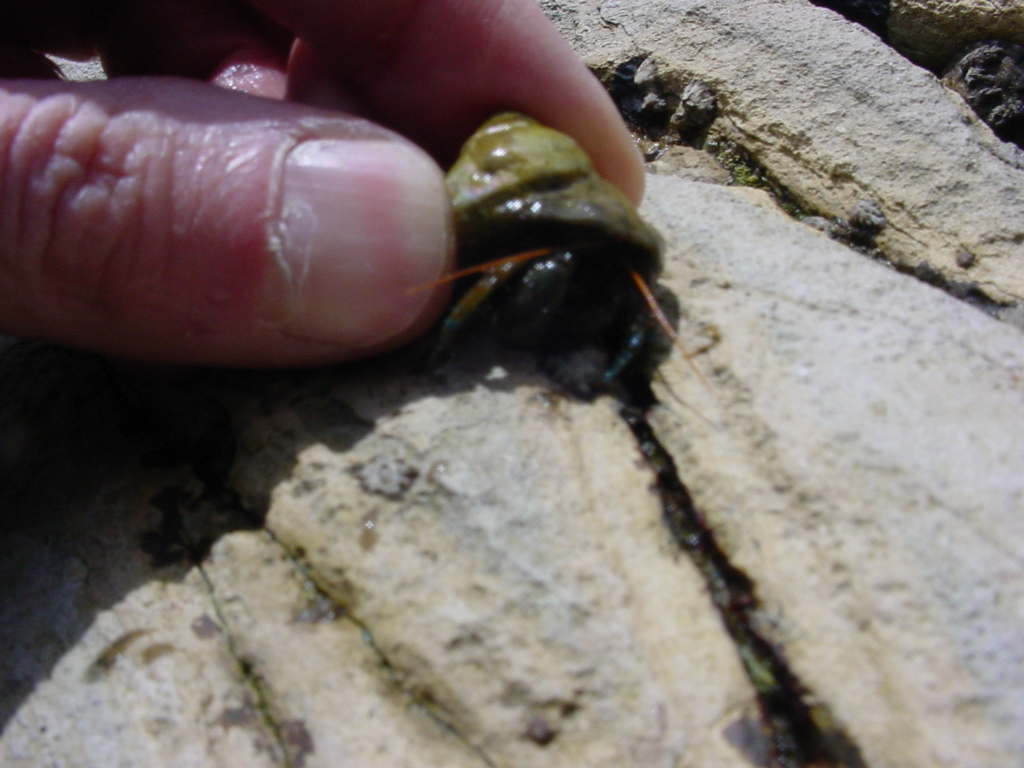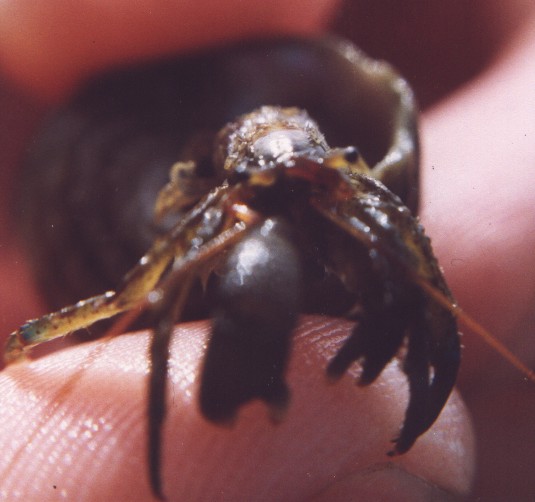Pagurus samuelis (Stimpson, 1857)Common name(s): Blueband hermit crab |
|
| Synonyms: Eupagurus samuelis |  |
| Phylum Arthropoda
Subphylum Crustacea Class Malacostraca Subclass Eumalacostraca Superorder Eucarida Order Decapoda Suborder Pleocyemata Infraorder Anomura Superfamily Paguroidea Family Paguridae |
|
| Pagurus samuelis in a Tegula funebralis shell. At Little Corona del Mar, CA | |
| (Photo by: Dave Cowles, March 2005) | |
How to Distinguish from Similar Species: The blue dactyls on the 2nd and 3rd legs, and the red unbanded antennae are distinctive. Of similar species, P. granosimanus has olive-green legs with small blue dots. P. beringanus is mostly subtidal and has a red band at the articulation of the propodus and dactyl.
Geographical Range: Alaska to Punta Eugenia, Baja California.
Depth Range: High intertidal to subtidal
Habitat: Rocky intertidal on the outer coast. Not often found in inland seas.
Biology/Natural History: One of the most common intertidal hermit crabs on the outer coast, especially in southern and central California. Reproduces in June and July in northern waters. This species seems to have a strong preference for Tegula funebralis shells, which they will steal from one another. Do not seem to kill the Tegula to get their shells. Active especially in the evening and at night. Adults eat algae, especially large brown algae and scavenge dead animals. Predators include the pile perch, sheephead, and spotted kelpfish. During courtship, male grasps female's shell and may carry her around for a day or longer, occasionally knocking his shell repeatedly against hers. Mating is brief (only a few seconds; both animals must nearly leave their shells to mate).
| Return to: | |||
| Main Page | Alphabetic Index | Systematic Index | Glossary |
References:
Dichotomous Keys:Allen, 1976
Flora and Fairbanks, 1966
Hart, 1982
Kozloff 1987, 1996
Smith and Carlton, 1975
Wicksten, 2009
General References:
Jensen,
1995
Kozloff,
1993
Morris
et al., 1980
Ricketts
et al., 1985
Scientific Articles:
Billock, W. L. and Dunbar, S. G. 2008. Influence of motivation on behavior in the hermit crab, Pagurus samuelis. Journal of the Marine Biological Association of the U. K., Published online by Cambridge University Press 19 Sep 2008 doi:10.1017/S0025315408002543: 1 – 5
dos Santos, Tyler S., Danilo S. Boskovic, Wendy Shih, and Stephen G. Dunbar, 2022. Heavy metals in the blueband hermit crab, Pagurus samuelis (Stimpson, 1857) (Decapoda: Anomura: Paguridae), from two Southern California habitats. Journal of Crustacean Biology 42:1 ruac015. https://doi.org/10.1093/jcbiol/ruac015
Shives, J. and Dunbar, S. G. 2010. Behavioral response to burial in the hermit crab, Pagurus samuelis: implications for the fossil record. Journal of Experimental Marine Biology and Ecology. 388: 33- 38
General Notes and Observations: Locations, abundances, unusual behaviors:

P. samuelis is often more willing than other hermit
crab species
to stick its legs out of the shell and try to escape.
Photo by Dave Cowles, April 1993. Dana Point, CA
Authors and Editors of Page:
Dave Cowles (2005): Created original page